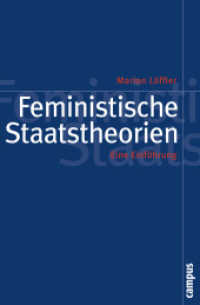基本説明
In contrast to traditional approaches of mainstream psycholinguists, the authors approach spontaneous spoken discourse as a dynamic process, rich with structures, patterns, and rules other than conventional grammar and syntax. Daniel C. O’Connell and Sabine Kowal thoroughly critique mainstream psycholinguistics, proposing instead a shift in theoretical focus from experimentation to field observation, from monologue to dialogue, and from the written to the spoken.
Full Description
In contrast to traditional approaches of mainstream psycholinguists, the authors of Communicating with One Another approach spontaneous spoken discourse as a dynamic process, rich with structures, patterns, and rules other than conventional grammar and syntax. Daniel C. O'Connell and Sabine Kowal thoroughly critique mainstream psycholinguistics, proposing instead a shift in theoretical focus from experimentation to field observation, from monologue to dialogue, and from the written to the spoken. They invoke four theoretical principles: intersubjectivity, perspectivity, open-endedness, and verbal integrity. Their analyses of historical and original research raise significant questions about the relationship between spoken and written discourse, particularly with regard to transcription and punctuation. With emphasis on political discourse, media interviews, and dramatic performance, the authors review both familiar and unexplored characteristics of spontaneous spoken communication, including: (1) The speaker's use of prosody. (2) The functions of interjections. (3) What fillers do for a living. (4) Turn-taking: Smooth and otherwise. (5) Laughter, applause, and booing: from individual listener to collective audience. (6) Pauses, silence, and the art of listening.
The paradigm shift proposed in Communicating with One Another will interest and provoke readers concerned about communicative language use - including psycholinguists, sociolinguists, and anthropological linguists.
Contents
A Critique of Mainstream Psycholinguistics.- The Problematic.- Empirical Methods.- Fluency and Hesitation.- The Written.- Foundations for Research on Spontaneous Spoken Discourse.- Rhetoric.- Intentionality.- From Monologism to Dialogicality.- Listening.- Empirical Research on Spontaneous Spoken Discourse.- Punctuation.- Transcription.- Pauses.- Prosody.- Fillers.- Interjections.- Referring.- Turn-taking.- Laughter.- Applause and Other Audience Reactions.- Toward a Theory of Spontaneous Spoken Discourse.- Intersubjectivity.- Perspectivity.- Open-endedness.- Verbal Integrity.- Spontaneous Spoken Discourse.- Communicating in Print about Communicating Orally.








